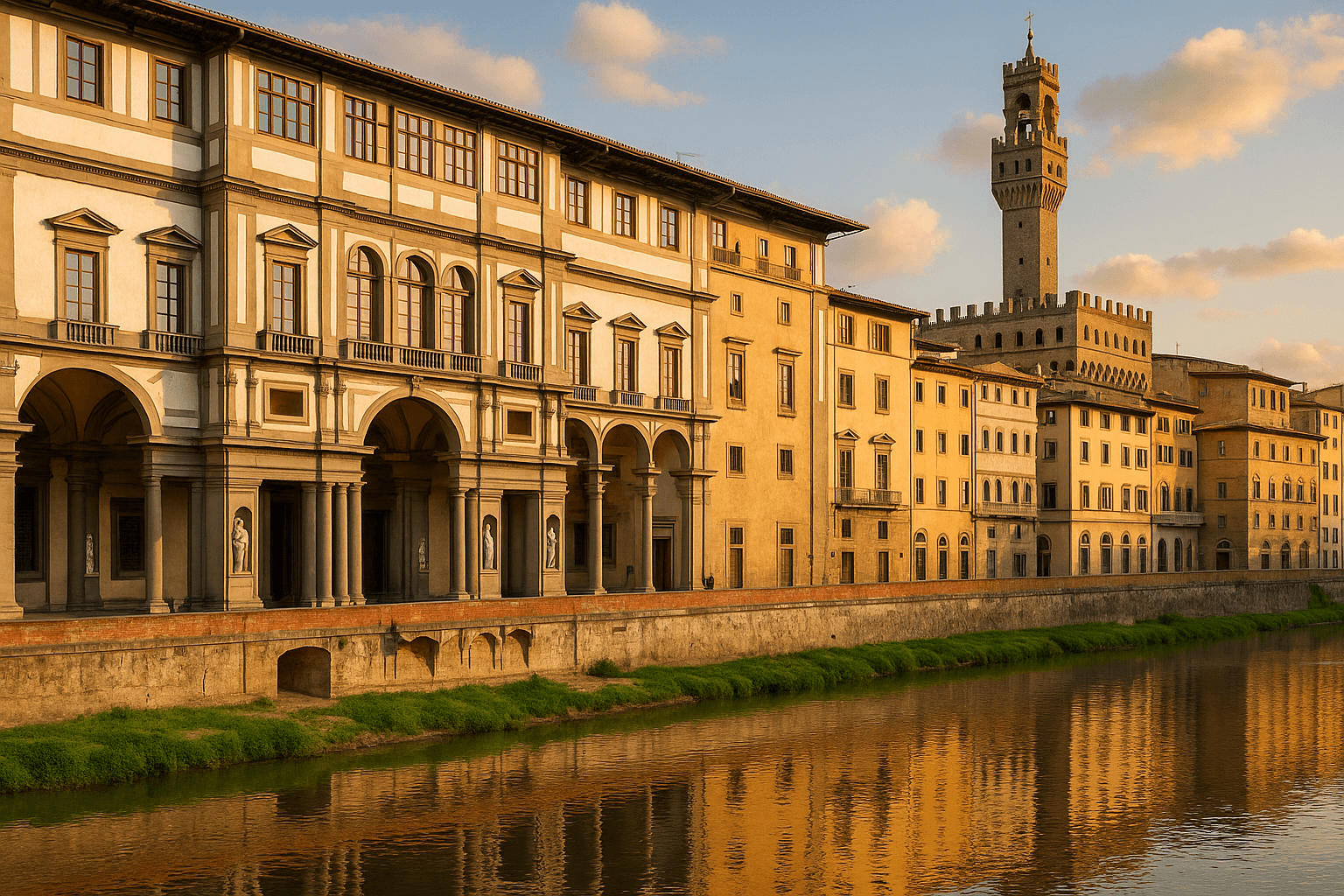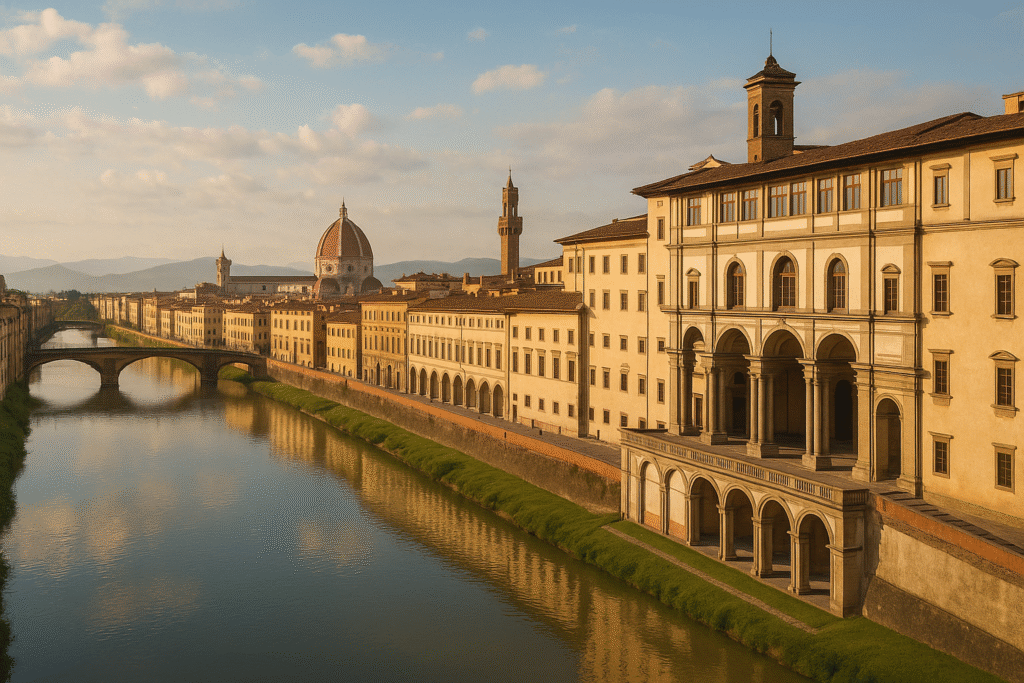Florence, a city where the past and present dance in a harmonious ballet, stands as a testament to human creativity and intellect. Its cobblestone streets are lined with architectural marvels that whisper tales of grandeur and innovation. As the cradle of the Renaissance, Florence is a living museum where art and architecture meld into the very fabric of life. Among its many treasures, the Uffizi Gallery holds a place of prominence, not just as a repository of art but as a beacon of Florence architecture. The recent restoration of this historic gallery has breathed new life into its ancient stones, offering a renewed view of both its past glory and future promise.
A Historical Tapestry
The Uffizi Gallery, originally designed by Giorgio Vasari in 1560 for Cosimo I de’ Medici, was conceived as a manifestation of the grandeur of Florence architecture. Its inception was part of a larger vision to exemplify the Medici’s influence through a modern administrative center. The structure itself, with its elegant arches and meticulously crafted facades, is a testament to the architectural genius of the Renaissance period. The gallery’s long corridors and expansive windows were designed to flood the space with natural light, enhancing both its aesthetic appeal and its functionality.
Over the centuries, the Uffizi has evolved from a symbol of political power to a sanctuary of art. Its transformation is a reflection of Florence’s own journey—where art, governance, and architecture intertwine seamlessly. The gallery’s halls have borne witness to the passage of time, hosting an unparalleled collection of masterpieces that chart the evolution of European art. This history is etched into the very walls of the Uffizi, making its restoration not just a renewal of a building, but a revival of Florence’s heritage.
The Restoration Vision
The restoration of the Uffizi Gallery was not merely an architectural endeavor; it was a meticulous act of preservation aimed at safeguarding a cultural legacy. The project, which spanned several years, was a collaborative effort involving architects, historians, and artisans dedicated to maintaining the integrity of Florence architecture. The restoration team faced the complex challenge of balancing modern needs with historical authenticity, a task that required both innovation and reverence for the past.
Central to the restoration was the enhancement of the gallery’s infrastructure. This included updating its climate control systems to better preserve the artwork, along with reinforcing the structural integrity of the building to withstand the test of time. The project also focused on improving visitor experience, ensuring that the Uffizi remains a welcoming space for art lovers from around the globe. Through these efforts, the restoration has succeeded in reinvigorating the gallery, ensuring its place as a cornerstone of Florence architecture for generations to come.
Architectural Details
The architectural nuances of the Uffizi Gallery are a study in Renaissance design, characterized by symmetry, proportion, and harmony. Vasari’s original design laid the groundwork for a new era of Florence architecture, one that emphasized clarity, balance, and an intellectual approach to space. The gallery’s restoration sought to highlight these elements, bringing Vasari’s vision into sharper focus for contemporary audiences.
One of the key aspects of the restoration was the careful attention paid to the gallery’s facades. The external stonework, weathered over centuries, was meticulously cleaned and restored, revealing the vibrant textures and hues that had been dulled by time. This renewal of the gallery’s exterior serves as a reminder of the meticulous craftsmanship that defines Florence architecture, inviting visitors to appreciate the artistry of the building itself as much as the treasures it houses.
The Role of Light
Light plays a pivotal role in the Uffizi Gallery, both as a design element and as a metaphor for enlightenment. Vasari’s design cleverly utilized natural light to enhance the display of artworks, a feature that was carefully preserved and enhanced during the restoration. The gallery’s expansive windows and strategic placement of skylights work in concert to illuminate the artworks, creating an ever-changing interplay of light and shadow that animates the space.
The restoration team recognized the significance of light in Florence architecture and sought to optimize it further. Advanced lighting systems were integrated to complement the natural light, ensuring that each masterpiece is viewed in its best light. This careful orchestration of illumination not only enhances the viewing experience but also underscores the gallery’s role as a beacon of artistic and intellectual enlightenment.

Modern Innovations
While the restoration remained faithful to the historical essence of the Uffizi, it also embraced modern innovations to enhance its functionality. The integration of cutting-edge technology was pivotal in transforming the gallery into a 21st-century cultural hub. This included state-of-the-art security systems, interactive displays, and enhanced digital infrastructure to support a seamless visitor experience.
These modernizations reflect a broader trend in Florence architecture, where historical structures are adapted to meet contemporary demands without compromising their heritage. The Uffizi’s restoration exemplifies this balance, demonstrating how tradition and innovation can coexist harmoniously. This approach ensures that the gallery remains relevant and accessible, bridging the gap between the past and the future.
The Cultural Impact
The restoration of the Uffizi Gallery has had a profound cultural impact, both within Florence and beyond. It reaffirms the city’s status as a global center of art and architecture, drawing visitors from around the world to experience its splendor. The renewed gallery serves as a catalyst for cultural exchange and dialogue, fostering a deeper appreciation for the rich tapestry of Florence architecture.
Moreover, the restoration project has invigorated the local community, providing opportunities for artisans, craftspeople, and scholars to engage in meaningful work. It has also inspired a renewed interest in the preservation of other historic sites in Florence, highlighting the importance of safeguarding cultural heritage for future generations. Through these efforts, the Uffizi continues to inspire, educate, and captivate, reinforcing its role as a cultural cornerstone.
Visitor Experience
For visitors, the restored Uffizi Gallery offers an enhanced experience that marries the grandeur of Florence architecture with the intimacy of art appreciation. The gallery’s thoughtful design and careful curation invite exploration and reflection, allowing visitors to engage with the artworks on a personal level. The expanded gallery spaces and improved amenities ensure a more comfortable and accessible visit, encouraging a deeper connection with the art and architecture on display.
Interactive exhibits and educational programs further enrich the visitor experience, providing context and insight into the gallery’s collection and the broader narrative of Renaissance art. These initiatives reflect a commitment to making the Uffizi not just a place to view art, but a vibrant space for learning and discovery. As a result, the gallery continues to captivate and inspire, offering a unique window into the world of Florence architecture and the enduring legacy of the Renaissance.
Conclusion
The restoration of Florence’s Uffizi Gallery is a triumph of architectural preservation and cultural renewal. It stands as a testament to the enduring legacy of Florence architecture, where history and innovation converge to create a living masterpiece. Through this meticulous restoration, the Uffizi has been reborn, offering a renewed glimpse into the past while paving the way for future generations to appreciate its beauty. As visitors wander through its hallowed halls, they are reminded of the power of art and architecture to transcend time, leaving an indelible mark on the human experience. In the heart of Florence, the Uffizi remains a beacon of inspiration, a celebration of the Renaissance reborn.

Recent Posts
15 Floor Plan Graphic Styles That Will Elevate Your Presentation Game
The Role of Shadows in Architectural Storytelling
When Furniture Becomes Architecture: Blurring the Line